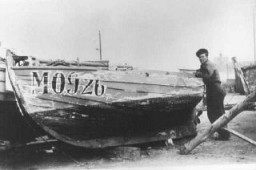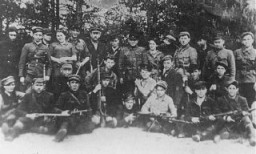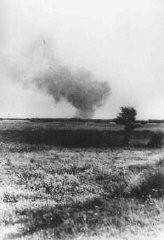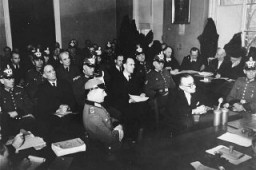
Killing Center Revolts
Killing Center Revolts The Warsaw ghetto uprising inspired revolts in other ghettos and in killing centers. Although many resisters knew they were bound to lose against overwhelmingly superior German forces, they chose to die fighting.
After the last Jews deported to Treblinka were gassed in May 1943, about 1,000 Jewish prisoners remained in the camp. Aware that they were soon to be killed, the prisoners decided to revolt. On August 2, armed with shovels, picks, and a few weapons stolen from the arms warehouse, they set fire to part of the camp and broke through its barbed-wire fence. About 300 prisoners managed to escape, and about a third of them survived German efforts to recapture them.
Two inmates of Sobibor, Aleksander Pechersky and Leon Feldhendler, planned a similar revolt in 1943. On October 14, prisoners killed eleven camp guards and set the camp on fire. About 300 prisoners escaped, but many were killed during the manhunt that followed. Fifty were alive at the war's end.
At Auschwitz-Birkenau, prisoners of the Sonderkommando—the special squad whose job it was to burn the corpses of the murdered victims—learned of the plans to kill them. On October 7, 1944, a group of them rebelled, killing three guards and extensively damaging the crematorium. Several hundred prisoners escaped, but most were later recaptured and killed. Four young women accused of supplying the dynamite were hanged in front of the remaining inmates. One of them, 23-year-old Roza Robota, shouted "Be strong, have courage," as the trap door opened.
Key Dates
August 2, 1943
Treblinka uprising
Early in 1943, deportations to the Treblinka killing center come to an end. In March the Germans commence Aktion 1005 in Treblinka. Aktion 1005 is the code name for the German plan to erase all evidence of mass murder. Prisoners are forced to open mass graves and burn the corpses. As this Aktion nears completion, prisoners fear that they will be killed and the camp dismantled. Resistance leaders in the camp decide to revolt. On August 2, 1943, prisoners quietly seize weapons from the camp armory, but are discovered before they can take over the camp. Hundreds of prisoners storm the main gate in an attempt to escape. Many are killed by machine-gun fire. More than 300 do escape; most are recaptured and killed by German police and troops. Most of the camp is burned by prisoners during the uprising. The surviving prisoners are forced to remove all remaining traces of the camp's existence. They too are then shot. Treblinka is finally dismantled in the fall of 1943. Between 870,000 and 925,000 people had been killed there.
October 14, 1943
Sobibor uprising
Aktion 1005 is implemented in the Sobibor killing center in the autumn of 1942, at the height of killing operations in the camp. In early 1943, deportations to Sobibor slowed and prisoners suspected that they would soon be killed and the camp dismantled. Prisoners form a resistance network in early 1943. They plan a revolt and mass escape from the camp. On October 14, 1943, the prisoners revolt, quietly killing German and Ukrainian guards. The guards open fire and prevent prisoners from reaching the main exit, forcing them to attempt escape through the minefield. About 300 escape; about 100 are recaptured and later shot. After the revolt, Sobibor is closed and dismantled. In all, at least 167,000 people were killed in Sobibor.
October 7, 1944
Auschwitz Sonderkommando uprising
During the summer of 1944, gassing operations in Auschwitz increase with the arrival of over 440,000 Hungarian Jews. The special prisoner detachments working in the killing area (the Sonderkommando) are increased to cope with the large number of gassings. By the fall of 1944, however, the detachments are again reduced in number. Members of the Sonderkommando, fearing that they will be killed, plan a revolt and escape. The plan for revolt is supported by women prisoners who smuggle gunpowder out of nearby factories to members of the Sonderkommando. On October 7, 1944, Sonderkommando prisoners revolt. During the revolt, crematoria IV is extensively damaged. It becomes inoperable and is never used again. Several SS guards are killed by prisoners during the revolt. The revolt is quickly suppressed by the camp guards. All members of the Sonderkommando are killed. Four of the women who smuggled gunpowder out of the factories are hanged on January 6, 1945, weeks before the camp is liberated.
January 17, 1945
Chelmno
Chelmno originally closed in March 1943, but reopened in June 1944 to facilitate the liquidation of the Lodz ghetto. Killing operations take place until mid-July 1944. Beginning in September 1944, a group of Jewish prisoners is forced to exhume and burn bodies from the mass graves at Chelmno as part of Aktion 1005, the German plan to erase all evidence of mass murder. On the night of The Soviet army approaches the Chelmno killing center. The Germans decide to abandon the camp. Before they leave, the Germans begin killing the remaining Jewish prisoners. Some of the prisoners resist and escape. Three prisoners survive. At least 172,000 people were killed in Chelmno.






